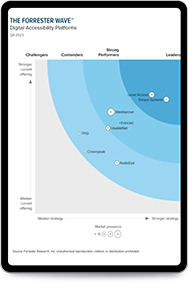The criticisms and objections of accessibility overlays
Aug 11, 2021
Editor’s note: This post is from eSSENTIAL Accessibility, which has since merged with Level Access. Since the publication of this post, Level Access has closely monitored the advancement of overlay technology capabilities. Our position on these tools has evolved based on many factors, including the impact of artificial intelligence (AI) on automated remediation. Our current perspective is captured in our blog post, Our Perspective: Digital Accessibility and Overlays.
eSSENTIAL Accessibility and Level Access have merged! Read More
Web accessibility overlay companies are causing noise and confusion in the market with claims about digital accessibility and WCAG conformance. The truth is, these tools cannot achieve WCAG conformance and leave site operators at significant risk of litigation under the ADA.
The disability community has been very clear in its opposition to overlay company claims, and mainstream media has recently taken notice. For example, from NBC News: “Blind people, advocates slam company claiming to make websites ADA compliant.” And another from Forbes: “Largest U.S. Blind Advocacy Group Bans Web Accessibility Overlay Giant accessiBe From Its National Convention.” The Forbes piece was prompted by the National Federation of the Blind’s (NFB) statement about accessiBe, perhaps the overlay with the most aggressive marketing. In that public statement, the NFB explained why it made the bold move to revoke accessiBe’s sponsorship of its annual convention, claiming that the company “currently engages in behavior that is harmful to the advancement of blind people in society.”In addition to negative news coverage, a group of more than 500 digital accessibility experts and advocates have called for the removal of overlays from websites in an informative, open letter on an Overlay Fact Sheet site.In this article, we tackle the criticisms and objections of overlays, helping clear confusion for organizations pursuing digital accessibility.
What is a digital accessibility overlay?
An accessibility overlay is a tool that claims to detect and fix web accessibility issues automatically by adding JavaScript code to your website. They are generally understood by the industry to only detect a small percentage of accessibility issues (see the risks section below). Accessibility overlays do not fix the website’s original source code but make changes on-the-fly in JavaScript (by dynamically “overlaying” new code on the original code).
What are the risks of using an overlay?
Overlays have significant limitations when considering digital accessibility:
- They can only address accessibility issues that can be identified programmatically, which is approximately 30% of WCAG 2.1 success criteria. From there, AI can only apply “fixes” to a subset of that 30%. The remaining unidentified 70% of success criteria requires manual evaluation with a human tester, using assistive technology (AT), to ensure that the experience is truly accessible for a person with a disability.
- The “fixes” the overlays make are automated, undocumented, and web operators can’t override the changes. When the overlay implements a change, it does so using an algorithm rather than human evaluation. Without human testing and oversight, it’s impossible to know if those changes actually make the experience accessible. For example, overlays will attempt to use automatic image recognition to populate the ALT attribute on image tags, but the attribute it applies is a guess, at best. There is no way to ensure that the text entered is accurate or meaningful.
- Automation will not be able to address every potential accessibility barrier in a critical user flow. Consider an ecommerce site that has a cart, order and purchasing systems. A visitor wants to select an item, place it in the cart, enter their payment and shipping information and complete their purchase. If even one step in the process is not accessible, it has rendered the entire purchasing system inaccessible.
- As a consequence of the lack of visibility, there is no reporting or management available through the overlay system. This leaves organizations in the uncomfortable position of not knowing the true state of accessibility, nor will they have a list of issues to work on to improve the underlying code or experience. Critically, if facing litigation, overlay users will not be able to demonstrate positive improvement in accessibility over time.
- And perhaps most harmful, the fixes that overlays implement can interfere with the assistive technology (AT) that users with disabilities rely on to engage with a site. The automated nature of the overlay can cause the system to produce results that negatively impact usability because these changes are implemented without human evaluation or oversight. Additionally, these users often already have their browsers and devices aligned to their preferred AT settings. Overlays often override these settings, which equates to a frustrating, user experience at minimum, but more likely a completely inaccessible one.
Bottom line, automation simply can’t understand how and why a human being engages with a site. It is beyond the capacity of overlay-only solutions to ensure that a person with disabilities can successfully navigate the critical user flows and use a site the way it was designed.
Can an overlay ensure web accessibility compliance?
Global legislation and U.S. case law refer to the W3C’s Web Content Accessibility Guidelines (WCAG) as the standard by which legal compliance is achieved. This means a website or app must conform with the technical standards defined in WCAG to avoid risk of non-compliance. And with automation only detecting approximately 30-percent of WCAG success criteria, compliance will not be achieved.
Is an overlay better than doing nothing?
While overlays can make some corrective changes to a site, again, they are only able to identify approximately 30% of WCAG success criteria and fix a subset of that 30%. This means they are not testing against the majority of standards, making them incomplete tools for organizations that want to achieve digital accessibility.And overlays are increasingly putting companies at legal risk. Some law firms are specifically citing the use of an overlay in their lawsuits, claiming that accessibility overlays indicate that the organization knew there was a problem but chose a non-compliant solution.
Why accessibility advocates are speaking out
On OverlayFactSheet.com, accessibility proponents say, “We will never advocate, recommend, or integrate an overlay which deceptively markets itself as providing automated compliance with laws or standards.”This community is largely concerned with the inaccuracy of overlay providers’ claims that their solution will make a site fully accessible. We know automated-only solutions are incapable of providing complete coverage. In addition, the absence of human testing and oversight means many issues are not identified, much less fixed, or a computer makes an invalid “fix” altogether.By claiming their client sites will become fully accessible with just an overlay, these companies are wrongly convincing their clients that they do not need to do anything further to make their site accessible. As a result, more sites simply remain inaccessible. Because these providers’ business models are based on technology-only solutions, they are resistant to, if not outright dismissive of this feedback from the disability advocacy community.
The eSSENTIAL Accessibility approach
As alluring as it may seem, there’s no quick-fix for digital accessibility, including accessibility overlay tools. The WCAG standards are complex and the legal requirements can be confusing. Getting your digital properties compliant with ADA, AODA, Section 508 and other global regulations takes time and requires an ongoing, multifaceted approach. Ours combines the efficiencies of technology with human expertise and legal consultation. We work to identify every accessibility error by coupling automation with manual testing conducted by individuals with disabilities. We support, train and enable your team to ensure ongoing compliance, and we monitor for any new errors introduced as you create new content. Our in-house legal team also steps in to help navigate any lawsuit or complaint you may be facing. Achieving accessibility compliance in this comprehensive way will properly protect your business from potential legal action and allow users with disabilities to engage with your website equally, in a way that works for them.To see a demo of our all-in-one platform, contact our team today.
Subscribe for updates

